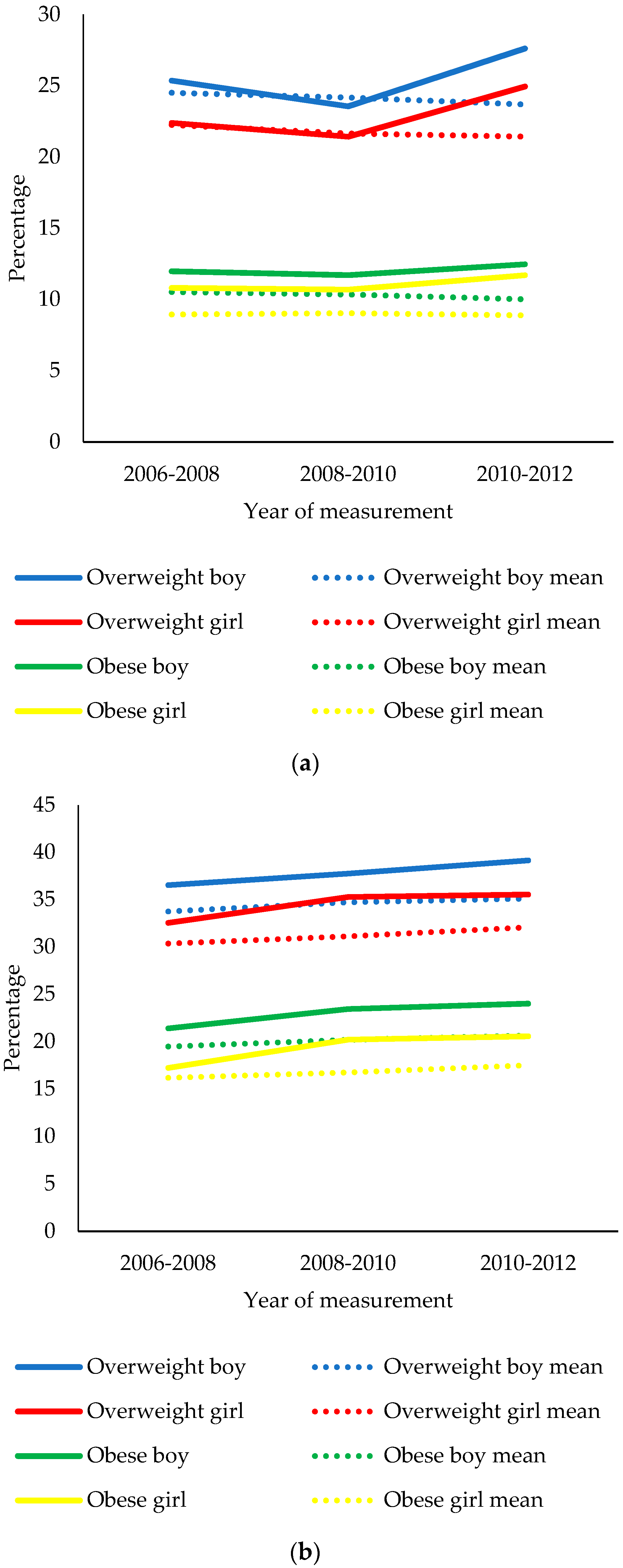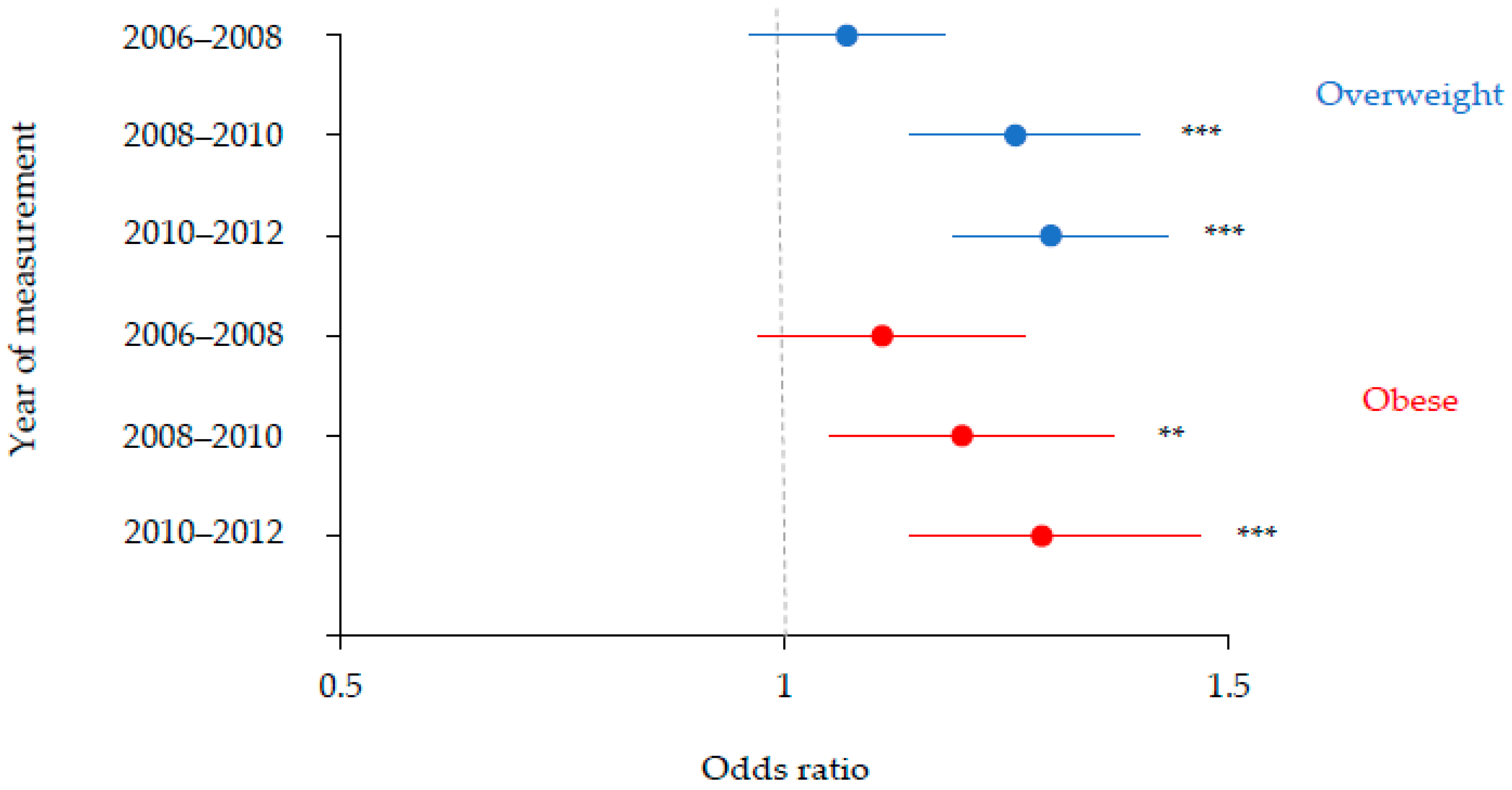Prevalence of Childhood Overweight and Obesity in Liverpool between 2006 and 2012: Evidence of Widening Socioeconomic Inequalities
Abstract
1. Introduction
2. Materials and Methods
2.1. Participants
2.2. Measures
2.2.1. Childhood Overweight and Obesity
2.2.2. Socioeconomic Inequality
2.3. Analysis
3. Results
3.1. Study Aim 1
3.2. Study Aim 2
4. Discussion
5. Conclusions
Funding
Acknowledgments
Conflicts of Interest
References
- World Health Organization. Population-Based Approaches to Childhood Obesity Prevention; World Health Organization: Geneva, Switzerland, 2012. [Google Scholar]
- NCD Risk Factor Collaboration (NCD-RisC). Worldwide trends in body-mass index, underweight, overweight, and obesity from 1975 to 2016: A pooled analysis of 2416 population-based measurement studies in 128·9 million children, adolescents, and adults. Lancet 2017, 390, 2627–2642. [Google Scholar] [CrossRef]
- Hayes, H.M.; Eisenmann, J.C.; Pfeiffer, K.; Carlson, J.J. Weight Status, Physical Activity, and Vascular Health in 9- to 12-Year-Old Children. J. Phys. Act. Health 2013, 10, 205–210. [Google Scholar] [CrossRef] [PubMed]
- Wild, S.H.; Byrne, C.D. ABC of obesity: Risk factors for diabetes and coronary heart disease. BMJ 2006, 333, 1009–1011. [Google Scholar] [CrossRef] [PubMed]
- Reilly, J.J.; Kelly, J. Long-term impact of overweight and obesity in childhood and adolescence on morbidity and premature mortality in adulthood: Systematic review. Int. J. Obes. 2011, 35, 891–898. [Google Scholar] [CrossRef] [PubMed]
- Noonan, R.J.; Boddy, L.M.; Knowles, Z.R.; Fairclough, S.J. Cross-sectional associations between high-deprivation home and neighbourhood environments, and health-related variables among Liverpool children. BMJ Open 2016, 6, e008693. [Google Scholar] [CrossRef] [PubMed]
- Noonan, R.J.; Fairclough, S.J. Is there a deprivation and maternal education gradient to child obesity and moderate-to-vigorous physical activity? Findings from the Millennium Cohort Study. Pediatr. Obes. 2018, 13, 458–464. [Google Scholar] [CrossRef] [PubMed]
- Stafford, M.; Marmot, M. Neighbourhood deprivation and health: Does it affect us all equally? Int. J. Epidemiol. 2003, 32, 357–366. [Google Scholar] [CrossRef] [PubMed]
- Cetateanu, A.; Jones, A. Understanding the relationship between food environments, deprivation and childhood overweight and obesity: Evidence from a cross sectional England-wide study. Health Place 2014, 27, 68–76. [Google Scholar] [CrossRef] [PubMed]
- Maguire, E.R.; Burgoine, T.; Monsivais, P. Area deprivation and the food environment over time: A repeated cross-sectional study on takeaway outlet density and supermarket presence in Norfolk, UK, 1990–2008. Health Place 2015, 33, 142–147. [Google Scholar] [CrossRef] [PubMed]
- Jones, N.R.V.; Tong, T.Y.N.; Monsivais, P. Meeting UK dietary recommendations is associated with higher estimated consumer food costs: An analysis using the National Diet and Nutrition Survey and consumer expenditure data, 2008–2012. Public Health Nutr. 2017, 21, 948–956. [Google Scholar] [CrossRef] [PubMed]
- Hardy, L.L.; Kelly, B.; Chapman, K.; King, L.; Farrell, L. Parental perceptions of barriers to children’s participation in organised sport in Australia. J. Paediatr. Child Health 2010, 46, 197–203. [Google Scholar] [CrossRef] [PubMed]
- Bhandari, R.; Kasim, A.; Warren, J.; Akhter, N.; Bambra, C. Geographical inequalities in health in a time of austerity: Baseline findings from the Stockton-on-Tees cohort study. Health Place 2017, 48, 111–122. [Google Scholar] [CrossRef] [PubMed]
- Conrad, D.; Capewell, S. Associations between deprivation and rates of childhood overweight and obesity in England, 2007–2010: An ecological study. BMJ Open 2012, 2, e000463. [Google Scholar] [CrossRef] [PubMed]
- Goisis, G.; Sacker, A.; Kelly, Y. Why are poorer children at higher risk of obesity and overweight? A UK cohort study. Eur. J. Public Health 2015, 26, 7–13. [Google Scholar] [CrossRef] [PubMed]
- van Jaarsveld, C.H.M.; Gulliford, M.C. Childhood obesity trends from primary care electronic health records in England between 1994 and 2013: Population-based cohort study. Arch. Dis. Child. 2015, 100, 214–219. [Google Scholar] [CrossRef] [PubMed]
- Wabitsch, M.; Moss, A.; Kromeyer-Hauschild, K. Unexpected plateauing of childhood obesity rates in developed countries. BMC Med. 2014, 12, 17. [Google Scholar] [CrossRef] [PubMed]
- Stamatakis, E.; Wardle, J.; Cole, T.J. Childhood obesity and overweight prevalence trends in England: Evidence for growing socioeconomic disparities. Int. J. Obes. 2010, 34, 41–47. [Google Scholar] [CrossRef] [PubMed]
- White, J.; Rehkopf, D.; Mortensen, L.H. Trends in socioeconomic inequalities in body mass index, underweight and obesity among English children, 2007–2008 to 2011–2012. PLoS ONE 2016, 11, e0147614. [Google Scholar] [CrossRef] [PubMed]
- Department for Communities and Local Government. The English Indices of Deprivation 2015; Communities and Local Government Publications: Wetherby, UK, 2015.
- Public Health England. Child Health Profile; Public Health England: London, UK, 2018.
- Boddy, L.M.; Hackett, A.F.; Stratton, G. Changes in BMI and prevalence of obesity and overweight in children in Liverpool, 1998–2006. Perspect. Public Health 2009, 129, 127–131. [Google Scholar] [CrossRef] [PubMed]
- Department of Health. PSA Obesity Target; Department of Health, the Department of Culture Media and Sport and the Department for Education and Skills: London, UK, 2004.
- Parnell, D.; Millward, P.; Widdop, P.; King, N.; May, A. Sport policy and politics in an era of austerity. Int. J. Sport Policy Politics 2018, 10, 1–5. [Google Scholar] [CrossRef]
- Dawson, J.; Huikuri, S.; Armada, F. Liverpool Active City 2005–2010: Increasing Population Physical Activity Levels Through Intersectoral Action. J. Phys. Act. Health 2015, 12, 749–755. [Google Scholar] [CrossRef] [PubMed]
- Taste for Health. Available online: http://www. tasteforhealth.com (accessed on 10 October 2018).
- Taylor, S.; Hackett, A.; Stratton, G.; Lamb, L. SportsLinx: Improving the health and fitness of Liverpool’s youth. Educ. Health 2004, 22, 3–7. [Google Scholar]
- National Children’s Bureau. Cuts That Cost: Trends in Funding for Early Intervention Services; National Children’s Bureau: London, UK, 2015.
- UK Parliament. Impact of the Spending Review on Health and Social Care. 2016. Available online: https://www.publications.parliament.uk/pa/cm201617/cmselect/cmhealth/139/13902.htm?utm_source=139&utm_medium=fullbullet&utm_campaign=Modulereports (accessed on 12 May 2018).
- The Guardian. In Liverpool, Tory Cuts Have Brought a City and Its People to Breaking Point. 2017. Available online: https://www.theguardian.com/commentisfree/2017/mar/23/liverpooltory-cuts-city-benefits-poorest (accessed on 12 May 2018).
- Davis, A.; Hirsch, D.; Padley, M. A Minimum Income Standard for the UK in 2014; Joseph Rowntree Foundation: York, UK, 2014. [Google Scholar]
- Public Health England. National Child Measurement Programme Operational Guidance; Public Health England: London, UK, 2014.
- Cole, T.J.; Freeman, J.V.; Preece, M.A. Body mass index reference curves for the UK. Arch. Dis. Child. 1995, 73, 25–29. [Google Scholar] [CrossRef] [PubMed]
- Department for Communities and Local Government. The English Indices of Deprivation 2010; Communities and Local Government Publications: Wetherby, UK, 2010.
- The NHS Information Centre. National Child Measurement Programme: England, 2006/07 School Year; Department of Health: London, UK, 2007.
- The NHS Information Centre. National Child Measurement Programme: England, 2007/08 School Year; Department of Health: London, UK, 2008.
- The NHS Information Centre. National Child Measurement Programme: England, 2008/09 School Year; Department of Health: London, UK, 2009.
- The NHS Information Centre. National Child Measurement Programme: England, 2009/10 School Year; Department of Health: London, UK, 2010.
- The NHS Information Centre. National Child Measurement Programme: England, 2010/11 School Year; Department of Health: London, UK, 2011.
- The NHS Information Centre. National Child Measurement Programme: England, 2011/12 School Year; Department of Health: London, UK, 2012.
- Noonan, R.J. The effect of childhood deprivation on weight status and mental health in childhood and adolescence: Longitudinal findings from the Millennium Cohort Study. J. Public Health 2018. [Google Scholar] [CrossRef] [PubMed]
- Vizard, P.; Obolenskaya, P. Labour’s Record on Health 1997–2010; London School of Economics and Political Science: London, UK, 2013. [Google Scholar]
- Defra. Food Statistics Pocket Book: In Year Update; Defra: London, UK, 2014. [Google Scholar]
- Lambie-Mumford, H.; Green, M.A. Austerity, welfare reform and the rising use of food banks by children in England and Wales. Area 2017, 49, 273–279. [Google Scholar] [CrossRef]
- Loopstra, R.; Reeves, A.; Taylor-Robinson, D.; Barr, B.; McKee, M. Austerity, sanctions, and the rise of food banks in the UK. BMJ 2015, 350, h1775. [Google Scholar] [CrossRef] [PubMed]
- McGuinness, F.; Ward, M. Poverty in the Liverpool City Region; House of Commons: London, UK, 2017.
- Backholer, K.; Beauchamp, A.; Ball, K.; Turrell, G.; Martin, J.; Woods, J.; Peeters, A. A framework for evaluating the impact of obesity prevention strategies on socioeconomic inequalities in weight. Am. J. Public Health 2014, 104, e43–e50. [Google Scholar] [CrossRef] [PubMed]
- Olstad, D.L.; Teychenne, M.; Minaker, L.M. Can policy ameliorate socioeconomic inequities in obesity and obesity-related behaviours? A systematic review of the impact of universal policies on adults and children. Obes. Rev. 2016, 17, 1198–1217. [Google Scholar] [CrossRef] [PubMed]
- Public Health England. Change4Life. Available online: https://campaignresources.phe.gov.uk/resources/campaigns/17-change4life/overview (accessed on 21 November 2018).
- Taylor-Robinson, D.C. Bigger Cuts to Sure Start Children’s Centres in More Disadvantaged Areas. Available online: https://www.bmj.com/content/359/bmj.j5332/rr (accessed on 21 November 2018).
- MRC Epidemiology Unit. Food Environment Assessment Tool (Feat). Available online: http://www.feat-tool.org.uk/ (accessed on 21 November 2018).
- Sweeting, H.N. Measurement and Definitions of Obesity in Childhood and Adolescence: A field guide for the uninitiated. Nutr. J. 2007, 6, 32. [Google Scholar] [CrossRef] [PubMed]
- Javed, A.; Jumean, M.; Murad, M.H.; Okorodudu, D.; Kumar, S.; Somers, V.K.; Sochor, O.; Lopez-Jimenez, F. Diagnostic performance of body mass index to identify obesity as defined by body adiposity in children and adolescents: A systematic review and meta-analysis. Pediatr. Obes. 2015, 34, 791–799. [Google Scholar] [CrossRef] [PubMed]
- Cole, T.J.; Freeman, J.V.; Preece, M.A. British 1990 growth reference centiles for weight, height, body mass index and head circumference fitted by maximum penalized likelihood. Stat. Med. 1998, 17, 407–429. [Google Scholar] [CrossRef]
- Freeman, J.V.; Cole, T.J.; Chinn, S.; Jones, P.R.M.; White, E.M.; Preece, M.A. Cross sectional stature and weight reference curves for the UK, 1990. Arch. Dis. Child. 1995, 73, 17–24. [Google Scholar] [CrossRef] [PubMed]
- Pearce, M.; Webb-Phillips, S.; Bray, I. Changes in objectively measured BMI in children aged 4–11 years: Data from the National Child Measurement Programme. J. Public Health 2015, 38, 459–466. [Google Scholar] [CrossRef] [PubMed]
- Stamatakis, E.; Primatesta, P.; Chinn, S.; Falascheti, E. Overweight and obesity trends from 1974 to 2003 in English children: What is the role of socioeconomic factors? Arch. Dis. Child. 2005, 90, 999–1004. [Google Scholar] [CrossRef] [PubMed]
- Gonzalez-Casanova, I.; Sarmiento, O.L.; Gazmararian, J.A.; Cunningham, S.A.; Martorell, R.; Pratt, M.; Stein, A.D. Comparing three body mass index classification systems to assess overweight and obesity in children and adolescents. Revista Panamericana de Salud Pública 2013, 33, 349–355. [Google Scholar] [CrossRef] [PubMed]
- Lang, I.A.; Kipping, R.R.; Jago, R.; Lawlor, D.A. Variation in childhood and adolescent obesity prevalence defined by international and country-specific criteria in England and the United States. Eur. J. Clin. Nutr. 2011, 65, 143–150. [Google Scholar] [CrossRef] [PubMed]
- Falconer, C.L.; Park, M.H.; Croker, H.; Kessel, A.S.; Saxena, S.; Viner, R.M.; Kinra, S. Can the relationship between ethnicity and obesity-related behaviours among school-aged children be explained by deprivation? A cross-sectional study. BMJ Open 2014, 4, e003949. [Google Scholar] [CrossRef] [PubMed]
- Liverpool City Council. Ethnicity in Liverpool: 2011 Census. Available online: https://liverpool.gov.uk/media/9899/ethnicity-and-migration.pdf (accessed on 21 November 2018).
- HM Government. Childhood Obesity: A Plan for Action, Chapter 2; HM Government: London, UK, 2016.



© 2018 by the author. Licensee MDPI, Basel, Switzerland. This article is an open access article distributed under the terms and conditions of the Creative Commons Attribution (CC BY) license (http://creativecommons.org/licenses/by/4.0/).
Share and Cite
Noonan, R.J. Prevalence of Childhood Overweight and Obesity in Liverpool between 2006 and 2012: Evidence of Widening Socioeconomic Inequalities. Int. J. Environ. Res. Public Health 2018, 15, 2612. https://doi.org/10.3390/ijerph15122612
Noonan RJ. Prevalence of Childhood Overweight and Obesity in Liverpool between 2006 and 2012: Evidence of Widening Socioeconomic Inequalities. International Journal of Environmental Research and Public Health. 2018; 15(12):2612. https://doi.org/10.3390/ijerph15122612
Chicago/Turabian StyleNoonan, Robert J. 2018. "Prevalence of Childhood Overweight and Obesity in Liverpool between 2006 and 2012: Evidence of Widening Socioeconomic Inequalities" International Journal of Environmental Research and Public Health 15, no. 12: 2612. https://doi.org/10.3390/ijerph15122612
APA StyleNoonan, R. J. (2018). Prevalence of Childhood Overweight and Obesity in Liverpool between 2006 and 2012: Evidence of Widening Socioeconomic Inequalities. International Journal of Environmental Research and Public Health, 15(12), 2612. https://doi.org/10.3390/ijerph15122612




